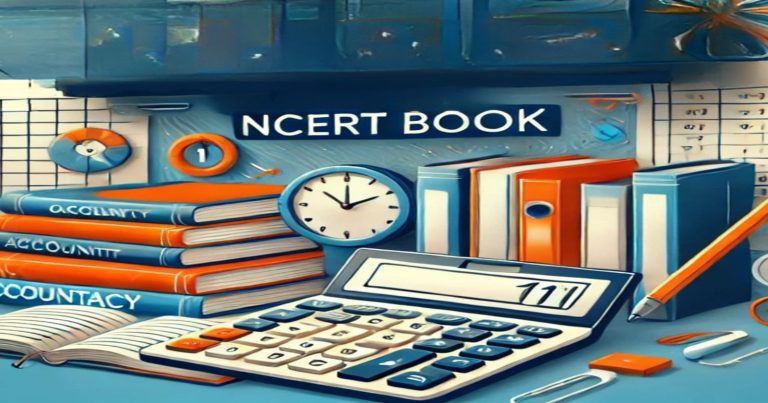The NCERT books for class 11 accountancy are an essential resource for any commerce student who studies up to class 11. This book is the foundation for understanding basic concepts and practices of accounting, which are important for an individual to understand if that person is interested in pursuing a career in the field of commerce or related fields. The Class 11 Accountancy book NCERT has been structured to expose students to the principles of financial accounting, bookkeeping, and financial statements.
NCERT Class 11 Accountancy Book PDF
The Class 11 Accountancy NCERT Book PDF is a must-download for all students who aim to know some of the most key accountancy concepts. Class 11 accounts NCERT book provides breakdown details of complex subjects in accounting and deals with an in-depth explanation of step-wise examples and clear illustrations. That is why Accounts Book class 11 NCERT helps students with the ability to navigate through complicated principles, building up a solid foundation in accountancy. This is a very structured approach to explanations, which would make it very valuable for students to understand challenging material and succeed in their classes.
| Download PDF for NCERT Class 11 Accountancy Book | |
| NCERT Book for Class 11 Accountancy – I (English) | Download PDF |
| NCERT Book for Class 11 Accountancy – II (English) | Download PDF |
| NCERT Book for Class 11 Accountancy – I (Hindi) | Download PDF |
| NCERT Book for Class 11 Accountancy – II (Hindi) | Download PDF |
Students who want to understand accountancy in Hindi can download the NCERT Accountancy Book Class 11 PDF in Hindi as well to get detailed answers and explanations of the exercises in the textbook.
Class 11 Accountancy Chapters PDF Free Download
Preparing for Class 11 Accountancy? Getting the NCERT Accountancy chapters in PDF is an excellent way to make your study routine easier. These PDFs offer detailed, step-by-step explanations of important concepts such as journal entries, ledgers, trial balances, and more. With simple examples and a systematic approach, they enable you to understand complicated topics easily. Whether you are preparing for exams or attempting to grasp complex concepts, these downloadable materials provide an easy means of studying at any time, anywhere. Download the NCERT Accountancy Class 11 chapters today and begin your quest towards mastering the subject!
| Download PDF for NCERT Class 11 Accountancy Part 1 Chapters | |
| Class 11 Accountancy-1 Chapter 1 | Download PDF |
| Class 11 Accountancy-1 Chapter 2 | Download PDF |
| Class 11 Accountancy-1 Chapter 3 | Download PDF |
| Class 11 Accountancy-1 Chapter 4 | Download PDF |
| Class 11 Accountancy-1 Chapter 5 | Download PDF |
| Class 11 Accountancy-1 Chapter 6 | Download PDF |
| Class 11 Accountancy-1 Chapter 7 | Download PDF |
| Download PDF for NCERT Class 11 Accountancy Part 2 Chapters | |
| Class 11 Accountancy-2 Chapter 1 | Download PDF |
| Class 11 Accountancy-2 Chapter 2 | Download PDF |
NCERT Class 11 Accountancy Book: Chapter-Wise Detail
The NCERT Class 11 Accountancy textbook is broken into two distinct parts in thirteen chapters, both offering a deep study of foundational accounting practices and principles. A detailed review and study of each chapter is given below, designed to give students a strong foundation in accountancy.
Chapter 1: Introduction to Accounting
The first chapter formulates the basic concepts and principles of accounting, brushing upon its purpose, underlying characteristics, merits, and demerits. It considers the role of accounting in most industries with the presentation of core accounting functions such as data analysis, detection of errors, and classification, measurement, and summarization concepts.
Chapter 2: Theory Base of Accounting
This one emphasises the necessity of a theoretical framework; this chapter deals with the basic concepts, principles, and standards required for accounting. It discusses the rules and regulations needed by the Institute of Chartered Accountants of India (ICAI), including the comprehensive accounting standards needed for consistency in accounting procedures.
Chapter 3: Recording of Transactions – I
Based on the fundamentals, the chapter explains the application of accounting transaction recording. It takes the students through source document organization, the accounting equation, and using debit and credit principles to correctly record transactions in the ledger.
Chapter 4: Recording of Transactions – II
Picking up from the last chapter, this chapter outlines the intricacies of how large businesses manage recording transactions. This brings in specialized journals such as purchase and sales books and other machinery used to record many transactions, making it easier to understand with step-by-step examples and real-life applications.
Chapter 5: Bank Reconciliation Statement
This chapter of the book outlines how bank reconciliation statements should be prepared, as well as the requirements. It refers to common cash book versus bank statement discrepancies and enhances students’ skills at adjustment and reconciliations of some financial accounts with a view towards obtaining the appropriate bank balance.
Chapter 6: Trial Balance and Rectification of Errors
Specializing in trial balances and error correction, this chapter explains how to prepare trial balances and identify accounting errors. It shows how to deal with and correct these imbalances and is a real-world guide to having accurate accounts.
Chapter 7: Depreciation, Provisions and Reserves
This chapter introduces the subject of depreciation, its causes, and how it is calculated. It distinguishes depreciation from related concepts such as depletion and amortization and the strategic value of setting up provisions and reserves in financial planning.
Chapter 8: Bill of Exchange
In terms of credit transactions, this chapter covers the fundamentals of bills of exchange according to the Negotiable Instruments Act of 1881. It provides insight into how the legal and practical aspects of handling bills of exchange and promissory notes in commercial transactions function.
Chapter 9: Financial Statements – I
This chapter introduces the preparation of financial statements and their relevance to stakeholders as well as the distinction between capital and revenue items. It guides learners through the procedures for preparing trading, profit and loss accounts, and balance sheets.
Chapter 10: Financial Statements – II
Following the subject of financial statements, in this chapter, the requirement for adjustments to the books of accounts is given. This chapter explains the adjustment for accruals, prepayment, bad debt, and provisions, ensuring that the students have learned how to fill out detailed financial statements.
Chapter 11: Accounts from Incomplete Records
This chapter covers cases where businesses maintain incomplete books. This chapter teaches students how to give estimates of financial outcomes employing different accounting techniques and situations for addressing real bookkeeping problems with incomplete data.
Chapter 12: Applications of Computers in Accounting
Highlighting the shift towards computer-based solutions, this chapter discusses the use of computer technology in accounting. It examines the advantages and disadvantages of computerized systems and the role of management information systems (MIS) in accounting.
Chapter 13: Computerised Accounting System
The last chapter of class 11 accountancy covers topics about computerized accounting systems. It compares manual and computerized systems and defines the operational advantages and disadvantages of contemporary accounting technologies.
Every chapter of the NCERT Class 11 Accountancy book is carefully crafted to equip students with theoretical knowledge as well as practical skills to prepare them for higher studies and professional accounting procedures.
Accountancy Class 11 NCERT Book FAQs
Where can I download the NCERT class 11 accountancy book PDF?
The NCERT accountancy book for Class 11 PDF can be downloaded from the official NCERT website or the link provided above in this article.
How can the NCERT accountancy book class 11 help in exam preparation?
The book is structured to cover all the essential topics in detail, supplemented with examples and practice exercises that are crucial for thorough exam preparation.
Can I access the NCERT accountancy book class 11 PDF in Hindi online?
Yes, the PDFs are accessible online and can be a great resource for Hindi-speaking students to understand complex accounting concepts clearly.
Is NCERT good for accountancy?
Yes, all the chapters present in NCERT Books for Class 12 Accountancy are important for the board exam as well as for higher studies.


